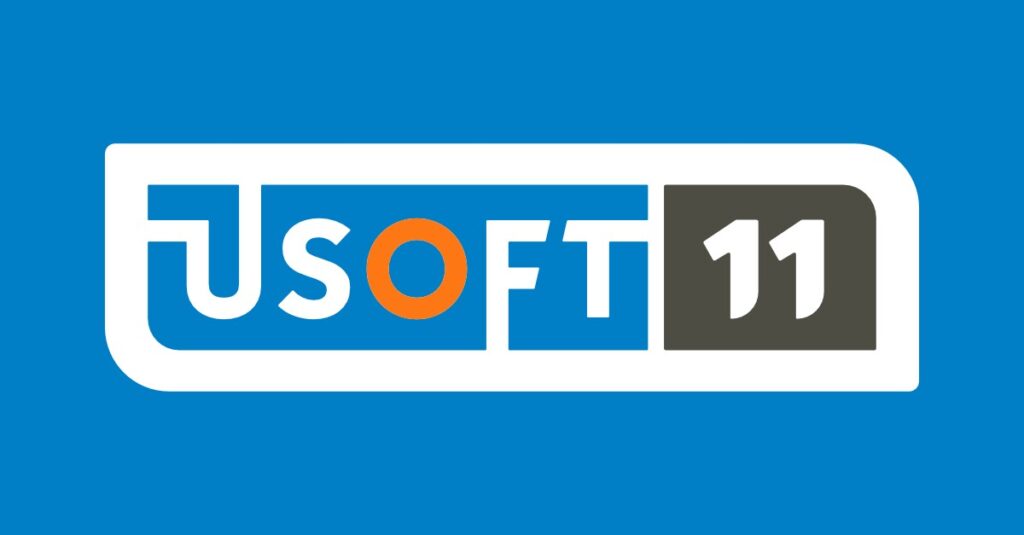It’s coming soon, USoft 11 – the latest version of the USoft low-code development platform. Packed with intriguing new features and improvements. It will boost team productivity, UI, and UX and will please our growing community of developers.
Our R&D team is working hard towards the coming release of USoft 11, expected in April this year. With this blog, we aim to provide you with initial insights into the new features and enhancements that are coming your way.
Key features
- Smart web templating
- A literally eye-catching feature is USoft’s smart web templating. This feature is extended in USoft 11 with a brand-new downloadable base template. This base template turns all meta knowledge, including roles, into a web app that is not only visually pleasant but also dynamically adapts to end-user rights. As a result, this feature impressively reduces web development time by looking at end-user rights to display only what a user is entitled to see and do, and by automatically generating your application fully in line with your pre-defined template and styling. This feature improves drag & drop functionality and will ensure that low-code developers are relieved from modifying web pages by “painting”, except for special demands a product owner may have in specific cases. To further support development speed, USoft provides the option to import existing front-end application component libraries to minimize the time required for specific web application demands. In addition, this import option will in the future also include multiple downloadable base templates for various application types.
- Repository version control & version comparison
- USoft developers do work on models, rules, jobs, UI paintings, and more by populating repositories: they “fill” metadata tables with records. In this default way of working, developers on a project work concurrently on a single central database. This has many advantages. You are quickly aware of changes by others. RDBMS user-concurrency capabilities are leveraged to manage commits cleanly.
- For teamwork in larger projects, USoft 11 now offers version control on this repository content. Teams can decide to extend their development environment with a file-based version control system for USoft metadata. The difference for developers is that their local work is automatically synced and can be merged and managed using a file-based version control system of their preference, for example, Git. This enables more advanced version control of a type more familiar to coders, including branching and merging facilities, the full history of development efforts, and present-day facilities for viewing differences (before states and after states).
- Repository objects in USoft 11 are identified not only by meaningful keys but also by GUIDs (meaningless globally unique identifiers). This makes it possible to identify a metadata record even between repositories. In particular, this gives you traceability of upgrades to values acting as a meaningful primary key.
- Interactive data modeling & enhanced Studio-App factory experience
- In many projects, product owners and development teams experience the value of USoft Studio, the web-based environment of the USoft platform for formulating the business reality in which the target solution will be put to use. USoft Studio uses various OMG standards, like SBVR (Semantics for Business Vocabulary and Business Rules) and BPMN, to structure terms, definitions, rules, and diagrams. Structured natural language has a self-organizing power: relationships are automatically understood and made navigable. Your business analysis findings become supremely clear and traceable. They are shaped in visual models and natural language that all stakeholders can use without a learning curve. The self-organizing power and clarity of Studio are unsurpassed and have led to impressive cost reduction, simply because the starting point of any development work is relieved from the traditional foggy state.
- SBVR in the App Factory (USoft Definer)
- USoft 11 strengthens its integration with Studio contents. The clarity of color-coded and hoverable SBVR formulations becomes available and navigable in the App factory development environment. For better integration, the existing ability to point at artefacts (such as Constraints) as being the implementation of a Studio specification has been improved.
- ER diagrams for metadata editing
- ER diagrams in USoft 11 have been moved from Studio to the development platform and are now interactive. Developers can still choose to traditionally declare their data model by filling in a form and then generate the solution. But they can now, alternatively, create metadata by drawing ER diagrams. USoft 11 stores the diagrams alongside the metadata and features automatic synchronization between the two. Later in the 11 series, decision models will be added to this way of working, starting with the ability to draw decision tables that are automatically synchronized with metadata.
- Template domains
- To enable data model specification based on ER diagrams alone, a new system of template domains is introduced. They are simple, popular data types such as Short Text, Long Text, Number, Amount, Date, and Boolean. This allows you to draw a simple type to start with. And you can always refine and diversify at domains level at any moment in time, as before.
- SBVR in the App Factory (USoft Definer)
- In many projects, product owners and development teams experience the value of USoft Studio, the web-based environment of the USoft platform for formulating the business reality in which the target solution will be put to use. USoft Studio uses various OMG standards, like SBVR (Semantics for Business Vocabulary and Business Rules) and BPMN, to structure terms, definitions, rules, and diagrams. Structured natural language has a self-organizing power: relationships are automatically understood and made navigable. Your business analysis findings become supremely clear and traceable. They are shaped in visual models and natural language that all stakeholders can use without a learning curve. The self-organizing power and clarity of Studio are unsurpassed and have led to impressive cost reduction, simply because the starting point of any development work is relieved from the traditional foggy state.
Technical features and enhancements
- Renewed runtime web UI
- The USoft web runtime has been renewed in USoft 11. In addition to a cleaner HTML5 output, all JavaScript has been modularized for the sake of a clean separation when 3rd party libraries are combined with USoft web solutions. Interference between 3rd-party functions and similar USoft-embedded functions is prevented. The embedded Web test recording, playback and benchmarking tooling that comes with USoft has an improved user experience, making web testing simpler and more fun.
- Revised UDB API
- USoft Web Designer outputs an API of UDB objects that allows a web UI to communicate with the Rules Engine. This code layer has been brought in line with current JavaScript standards. Obsolete technologies (jQuery, jQuery UI, handlebars, older Bootstrap versions) are being phased out and replaced by modern standards (latest Bootstrap, Vue3). This enables reactive pages among other things.
- .Net6 for Linux and Windows
- In the deployment area, the USoft 10 series already provided all needed to run USoft services in containers, both Windows and Linux. USoft 11 continues to make this even more seamless. A major new advancement is that USoft 11 now uses the same .net versions for both Windows and Linux, the long-term supported net6 version.
The USoft 11 series will add the option to switch to higher versions. For backward compatibility, the Windows version still supports the Windows API, allowing existing solutions to migrate to net6.
- In the deployment area, the USoft 10 series already provided all needed to run USoft services in containers, both Windows and Linux. USoft 11 continues to make this even more seamless. A major new advancement is that USoft 11 now uses the same .net versions for both Windows and Linux, the long-term supported net6 version.
- Security, Authorization & Access
- Security has always been a top priority in USoft. Both architecture and implementations are continuously adapted to the needs that follow from PEN tests, flaws in 3rd party libraries being used, and insights and requirements we get from our customer base. USoft 11 extended its authorization capabilities for components such as .Net, allowing application developers to limit rights based on roles and move foreground rights to background rights, i.e. disallowing users to directly invoke certain components by delegating component functionality to rules.
- Authorization, next iteration
- A complete overhaul of the USoft authorization system took place in USoft 10. Role-playing was drawn into the development environment. This allowed much richer features than before when authorization consisted essentially in distributing RDBMS grants. USoft 11 completes this transition by adding useful extras:
- Single sign-on (SSO) in C/S: In C/S, developers can now sign on to USoft development tools automatically using their Windows account.
- Simplified user model in USoft Authorizer: The USoft Authorizer model for application users has been simplified in several ways.
- Extended authorization: USoft 11 extends its authorization capabilities for components such as .NET components and USoft internal components, allowing application developers to limit rights based on roles and to move foreground rights to background rights. This disallows users to directly invoke certain components by delegating component functionality to rules. In USoft 11, you can authorize DDL actions in the RDBMS (CREATE, ALTER, DROP).
- A complete overhaul of the USoft authorization system took place in USoft 10. Role-playing was drawn into the development environment. This allowed much richer features than before when authorization consisted essentially in distributing RDBMS grants. USoft 11 completes this transition by adding useful extras:
- Authorization, next iteration
- Security has always been a top priority in USoft. Both architecture and implementations are continuously adapted to the needs that follow from PEN tests, flaws in 3rd party libraries being used, and insights and requirements we get from our customer base. USoft 11 extended its authorization capabilities for components such as .Net, allowing application developers to limit rights based on roles and move foreground rights to background rights, i.e. disallowing users to directly invoke certain components by delegating component functionality to rules.
- Browser control in C/S UIs
- USoft 11 also extends the versatility of traditional C/S applications for back-end power users. An exciting new feature in this area is a new browser control that will not only display application data enhanced by HTML5 but also allow instant communication with the USoft Rules Engine. This opens up very advanced C/S data rendering and takes away the burden of making controls obsolete techniques. For example, when a back-end application handles resource allocation (rooms, utilities, human resources, whatever you can imagine) a stunning HTML5-based representation can be displayed that acts interactively and updates the underlying data. Needless to say, this also facilitates hybrid applications where back-end power users experience the same look (data representation) as end users see in web UIs.
And many more
There are many additional features added to USoft 11 that will be presented in the final release notes, ranging from extended access to runtime meta to support for dynamic constraints based on languages such as JavaScript, Python or R. Many such features focus on the versatility of USoft solutions and bringing 3rd party software and algorithms to the low-code domain.
Last but not least, USoft 11 upgrades 3rd party libraries, both for the sake of security and versatility. Memory management, database drivers, JVM, and CLR drivers have all been improved and re-engineered. And USoft’s PostgreSQL support has been extended and will go into production in the 11 series.
We will share more information about this new release on a regular basis. Keep an eye on our community or the blog section of our website.




